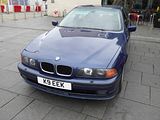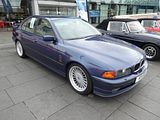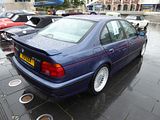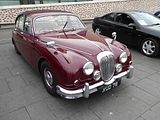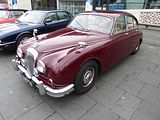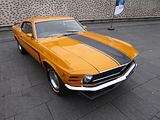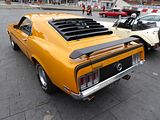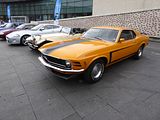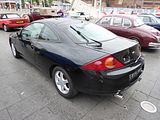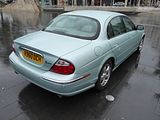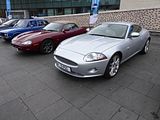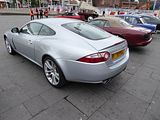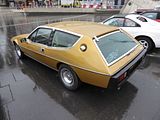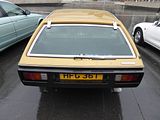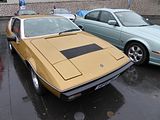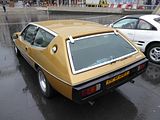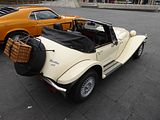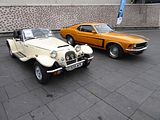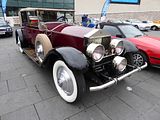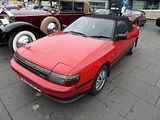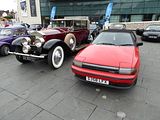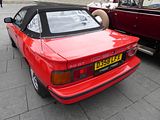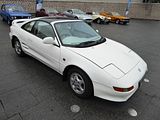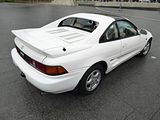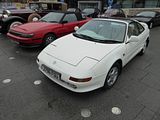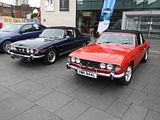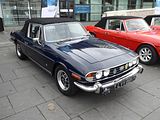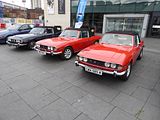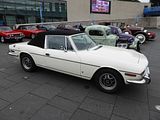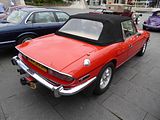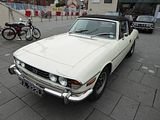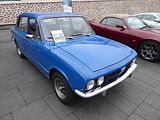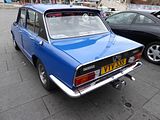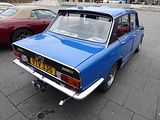Two months prior to this event, I attended the Coventry breakfast Club for the first time. There were plenty of cars there which I had not seen before, which was one of the reasons for going, but I was mildly disappointed as half of the vast area in front of the City’s Transport Museum which is where the event takes place, had been given over to an assembly of Jaguar/Land Rover vehicles which were gathered in advance of setting out on a charity run. So, whilst the event certainly ticked the “variety” box, there was simply less to see than has proved to be the case at many of the other Breakfast Club gatherings I have attended in the UK and further afield. I vowed to return, and the chance came in July when my work diary had me in the area the day before , and the weekend diary had an event at Chateau Impney, not that far away, making it logistically more sensible to stay over rather than go home and back again. The weather forecast was not particularly promising as I headed out of my hotel on the northern side of the city, to make the short drive to the Museum, to see what was on display. Sadly, the answer was “not much”, and in the following hour, not a lot more arrived, apart from some grey skies which then turned to rain. By 10 ‘clock, it looked unlikely that anything else was going to turn up, so I headed back to the car and to the bigger event of the day – a separate report for which will ensue – with just 40 photos of the cars attending to include here.
ALPINA
Not just alphabetically first, but also the first car I came to, as it was parked in the corner nearest to the currently closed off road, was this Alpina B10, a rare version of the E39 model 5 Series BMW. This was the first of the E39-based Alpina models, being launched at the March 1997 Geneva Show, and running for just 2 years before being replaced by a 3.3 litre version. It had an engine based on BMW’s 6 cylinder 2.8 litre unit, but enlarged to 3.2 litres, with lightweight Mahle pistons, modified cylinder head and combustion chamber, and a revised Siemens engine management system, all of which combined to give it an output of 260 bhp, making it almost as fast as the BMW 540i of the day. a car whose price it undercut. It was only offered with a 5 speed manual gearbox. Other Alpina changes included revised suspension, and the usual Alpina touches to the inside, A Touring version was also available. The later 3.3 model had 280 bhp from a 3.3 litre engine and the option of a Switchtronic automatic gearbox. There were also 340 bhp V8 and with the D10, diesel power E39-based models.
DAIMLER
It is tempting to declare that this car, a Daimler V8-250 is rare, too, but when I think about the number I have seen at events in recent months, perhaps it is not as uncommon as I may have concluded. Launched late in 1962, it was essentially a rebadged Jaguar Mark 2 fitted with Daimler’s 2.5-litre 142 bhp V8 engine and drive-train, a Daimler fluted grille and rear number plate surround, distinctive wheel trims, badges, and interior details including a split-bench front seat from the Jaguar Mark 1 and a black enamel steering wheel. Special interior and exterior colours were specified. Most cars were fitted with power-assisted steering but it was optional. Automatic transmission was standard; manual, with or without overdrive, became an option in 1967. The 2.5 V8 was the first Jaguar designed car to have the Daimler badge. A casual observer, though not its driver, might mistake it for a Jaguar Mark 2. The Daimler’s stance on the road was noticeably different from a Mark 2. In April 1964 the Borg-Warner Type 35 automatic transmission was replaced by a D1/D2 type, also by Borg-Warner. A manual transmission, with or without an overdrive unit usable with the top gear, became available on British 2.5 V8 saloon in February 1967 and on export versions the following month. Cars optioned with the overdrive had the original 4.55:1 final drive ratio. In October 1967, there was a minor face-lift and re-labelling of the car to V8-250. It differed only in relatively small details: “slimline” bumpers and over-riders (shared with the Jaguar 240/340 relabelled at the same time), negative-earth electrical system, an alternator instead of a dynamo and twin air cleaners, one for each carburettor. Other new features included padding over the instrument panel, padded door cappings and ventilated leather upholstery, reclinable split-bench front seats and a heated rear window. Power steering and overdrive were optional extras. Jaguar replaced its range of saloons—the 240, the 340, the 420, and the 420G—with the XJ6 at the end of 1968. The company launched the XJ6-based Daimler Sovereign the following year to replace the Daimler saloons—the 240-based V8-250 and the 420-based Sovereign. Henceforth all new Daimlers would be re-badged Jaguars with no engineering links to the pre-1960 Daimlers.
FORD
This very distinctive 1969 Ford Mustang was one of the cars which was at the event last time I came. For the first two years of Mustang production, the car’s appearance had changed little, but from 1967, Ford made the annual model updates which were common among all US manufacturers at the time. Whilst the 1967 and 1968 changes were largely concentrated on the front end, and the car was still visually quite like the very first 1964.5 models, the 1969 model year restyle “added more heft to the body” with the body length extended by 3.8 inches on the same 108 inch wheelbase, width increased by almost half an inch, and the Mustang’s “weight went up markedly too.” 1969 was the first model to use quad headlamps placed both inside and outside the grille opening. The corralled grille pony was replaced with the pony and tribars logo, set off-centre to the drivers side. The car was longer than previous models and sported convex rather than concave side panels. The fastback body version was renamed Sportsroof, styled as SportsRoof in Ford’s literature. The 1969 model year saw the introduction of the Mach 1, with a variety of powerplants options and many new styling and performance features. Distinctive reflective striping was placed along the body sides, with a pop-open fuel cap, dual exhausts, matte-black hood with simulated air scoop and NASCAR-style cable and pin tiedowns. It used steel wheels with bold-lettered Goodyear Polyglas tyres. A functional “shaker” bonnet scoop – which visibly vibrated by being attached directly to the air cleaner through a hole in the bonnet – was available, as were tail-mounted wing and chin spoilers and rear window louvered blackout shade. The Mach 1 featured a deluxe interior with simulated wood trim, high backed seats, extra sound deadening, remote sports mirrors and other comforts. The Mach 1 proved popular with buyers with 72,458 cars sold through 1969. The Boss 302 was created to meet Trans Am rules and featured distinctive hockey-stick stripes, while the understated Boss 429 was created to homologate the Boss 429 engine (based on the new Ford 385 series engine) for NASCAR use. The two Boss models received fame on the track and street and to this day they still demand premium pricing for their pedigree. 1628 Boss 302’s and 859 Boss 429’s were sold through 1969 – making these vehicles somewhat rare. A new “luxury” model became available starting for 1969, available in only the hardtop body style. The ‘Grande’ featured a soft ride, 55 pounds of extra sound deadening, as well as deluxe interior with simulated wood trim. It was popular with buyers with 22182 units sold through 1969. Amidst other special editions, the 1969 Mustang E was offered for those desiring high mpg. The 1969 Limited Edition Mustang E was a rare (about 50 produced) fastback special model designed for economy. It came with a six-cylinder 4.1 litre engine, a high stall torque converter for the standard automatic transmission and a very low, 2.33:1 rear axle ratio. Mustang E lettering on the rear quarters identified the special Mustang E. Air conditioning was not available on the ‘E’ model. The Mustang GT was discontinued in 1969 due to poor sales versus the success of the new Mach 1 with only 5396 GT models sold that year. Although 1969 continued with many of the same basic V8 engines available on 1968 models, notably a now revised 302 cu in (4.9 litre) Windsor engine with 220 hp, the 390 cu in (6.4 litre) FE with 320 hp and the recently launched 428 cu in (7.0 litre) Cobra Jet engine (with or without Ram-Air) with an advertised 335 hp, a variety of revised options and changes were introduced to keep the Mustang fresh and competitive including a new performance V8 available in 250 hp or 290 hp tune known as the 351 cu in (5.8 litre) Windsor (351W), which was effectively a stretched and revised 302 cu in (4.9 litre) to achieve the extra stroke. The 428 cu in (7.0 litre) Cobra Jet engine continued unchanged in the 1969 and 1970 model years and continued to be advertised at just 335 hp despite being closer to 410 hp. However, whenever a V or W axle was ordered (3.90 or 4.30 locking ratio) on any Cobra Jet Mustang, this kicked in various engine improvements which were designed to make the engine more reliable on the strip. These improvements included an engine oil cooler (which resulted in AC not remaining an option), stronger crankshaft and conrods and improved engine balancing and was named the ‘Super Cobra Jet’. On the order form, these improvements were later referred to as ‘Drag Pack’. Today, these models request a premium price despite offering no notable performance increase other than provided by their unique axle ratios. The 1969 Shelby Mustang was now under Ford’s control and made to look vastly different from regular production Mustangs, despite now being built inhouse by Ford. The custom styling included a fibreglass front end with a combination loop bumper/grille that increased the car’s overall length by 3 inches as well as five air intakes on the bonnet. Two models were available, GT-350 (with a 351 cu in (5.8 litre) Windsor (351W) producing 290 hp and GT-500 (with the 428 cu in (7.0 litre) Cobra Jet engine), in both sportsroof or convertible versions. All 1969–1970 Shelby Mustangs were produced in 1969. Because of dwindling sales, the 789 remaining 1969 cars were given new serial numbers and titled as 1970 models. They had modified front air dam and a blackout paint treatment around the hood scoops. The 1970 model year Mustangs were restyled again, to be less aggressive and therefore returned to single headlamps which were moved to the inside of the grille opening with ‘fins’ on the outside of the grille sides. Some felt the aggressive styling of the 1969 model hurt its sales and this view prompted the headlamp revisions and simplification of other exterior styling aspects. It’s worth noting though that 1969 model year sales exceeded those of 1970. The rear fender air scoops were removed and the taillight panel was now flat instead of concave as seen on 1969 models. The interior options remained mostly unchanged.
The other Ford here was also a Coupe, but more recent, an example of the Cougar, Ford’s second attempt to find a replacement for the much loved Capri, and a rival to the popular Vauxhall Calibra and Rover 200 Coupe models which had proved that there was still a market for cars of this genre. The first attempt had been the Mazda MX-6-based Probe, which although initially conceived to replace the Mustang, had been positioned below that car in Ford’s US range, and in second generation guise had been brought over to Europe, where it found little favour. With the Cougar, Ford decided to try again, and with a global market in mind. Just as the Capri had been based on the Cortina, the Cougar was based on the large family car available at the time, the Mondeo. The European launch was in July 1998 at the British Grand Prix at Silverstone. The television advertisements featured the silver model driven by Dennis Hopper due to his appearance in the film Easy Rider. At the same time, Steppenwolf’s 1968 hit “Born To Be Wild” played, as this was featured in the film and the same scene the advertisement recreated. US market cars were shown some six months later. Although visually very similar, there were some differences. Cars destined to be sold in Europe and the United Kingdom were finished in Ford’s Köln plant in Germany, where the cars had European-specification lighting installed, Ford badges applied whilst for the United States market, there was different branding, with the car known as the Mercury Cougar. The car came equipped with the 2.0-litre 16-valve Zetec or 2.5-litre 24-valve Duratec V6 engines with two specification levels, largely equivalent to a Mondeo Ghia (standard) and Ghia X (simply X). Manual and automatic transmissions were available. All variants came with 16-in alloy wheels as standard. Although it was praised for being good to drive, sales were not strong. After the first two years of production, only 12,000 units reportedly had been sold in the United Kingdom, and the model was deleted after just four years. in 2002. It continued a little longer in the US and Australia. There was no direct replacement.
JAGUAR
When I enquired about including my own car in the event, I was told there was a very strict 20 year age requirement. Clearly, this is not universally enforced, as none of these Jaguars are as old as that. Just as well they were here, though, to boost the numbers! The cars were an S Type, an XK8 and the later XK Coupe.
LOTUS
There was another chance to see this striking gold coloured Elite 503. Announced in 1974, the Type 75 Elite was the first of a new generation of Lotus cars which represented a concerted push up-market. The imposition of VAT had effectively killed off the market for the range of models that Lotus had hitherto produced as kit cars, and the only way to stay profitable was to produce something which could sold at higher prices. So whilst Lotus would tell you that the Elite was a replacement for the Lotus Elan Plus 2, it was more accurate to say that it was a rival for cars like the Reliant Scimitar GTE and Lancia Beta HPE. The styling was quite unlike anything that Lotus had produced before, with distinctive wedge lines penned by Oliver Winterbottom which hid the fact that the bodies were produced out of two separate glassfibre moulds and they had to join up in the middle around the waistline. The shooting brake style, with a hatchback as well as the fact that the Elite had 4 seats made it reasonably practical. luggage compartment. Mechanically there were fewer surprise. It was front engined with rear wheel drive, and had 4-wheel independent suspension using coil springs. The Elite was Lotus’ first car to use the 907 aluminium-block 4-valve, DOHC, four-cylinder, 1973cc, developing 155 bhp. which had previously been used in the Jensen-Healeys, where all the reliability issues had been found) The 907 engine ultimately became the foundation for the 2.0 litre and 2.2 litre Lotus Esprit powerplants, the naturally aspirated 912 and the turbocharged 910. The Elite was fitted with a 4 or 5 speed gearbox and from January 1976 automatic transmission was optional. The Elite had a claimed drag co-efficient of 0.30 and at the time of launch it was the world’s most expensive four cylinder car. Elites were available in 4 main specification variations, 501, 502, 503, and later on 504. The 501 was the ‘base’ version. The 502 added air conditioning, the 503 had power steering and the 504 added automatic transmission. The Elite was the basis for a coupe model, the Eclat which was launched in October 1975. Facelifted versions of both came in 1980, with a larger 2.2 litre engine and refinements to the trim. The Elite would live a couple of years in this form, but market interest shifted to the Coupe and when this was given a more significant revision a couple of years later, and a new name of Excel, the Elite was dropped from the range. Although 2535 of them were made, they are rare these days.
PANTHER
Another car which was here last time I visited was this 1987 Panther Kallista. A largely forgotten marque these days, Panther Westwinds of Byfleet in Surrey built a series of pastiche models in the 1970s, starting with the Jaguar SS100 inspired J72 that was launched in 1972. After heading upmarket still further with the DeVille and then producing the amazing 6 wheeled Six, which never got beyond a couple of cars, a model with greater volume prospects arrived in 1977. Called Lima, it used Vauxhall mechanicals under its glassfibre body which echoed the styling of British sports cars from the 1930s and 1940s, 897 units were made before it was updated and renamed in 1982 as the similar looking Kallista. This car had an aluminium body and used Ford mechanicals, including a range of engines from a 1.6 litre 4 cylinder to the 2,8 Essex and later 2.9 litre Cologne V6 units. There was a small but steady market for the car, and it would be produced throughout the 1980s, and it was only when Panther over-reached itself with the ambitious Solo that the company collapsed. Korean giant Ssangyong bought what remained and produced a badge engineered version in 1992 called the SsangYong Kallista. Only 78 of the SsangYong models were ever built.
RODS
Starting life as a mid 30s Ford, this Rod represents one person’s vision of something rather different.
ROLLS ROYCE
Another car which I had seen at the event a couple of months previously was this very stately and imposing Rolls Royce Phantom I. Dating from 1927, it was not built at Crewe, but at Springfield, Massachusets, in the US. Many people are probably unaware of the fact that for a while Rolls Royce produced cars on both sides of the Atlantic. The Phantom had been introduced in 1925, as a replacement for the Silver Ghost. This was Rolls-Royce’s second 40/50 hp model and to differentiate between the 40/50 hp models, Rolls-Royce named the new model “New Phantom” and renamed the old model “Silver Ghost”, which was the name given to their demonstration example, Registration No. AX201. When the New Phantom was replaced by another 40/50 hp model in 1929, the replacement was named Phantom II and the New Phantom was renamed Phantom I. One major improvement over the Silver Ghost was the new pushrod-OHV straight-6 engine. Constructed as two groups of three cylinders with a single detachable head, the engine was described by Rolls-Royce as producing “sufficient” power, a term that they would use until into the 1990s. The engine used a 4¼ in (107.9 mm) bore and undersquare 5½ in (139.7 mm) stroke for a total of 7,668 cc of displacement. In 1928, the cylinder heads were upgraded from cast iron to aluminium; this caused corrosion problems. The separate gearbox connected through a rubberised fabric flexible coupling to the clutch and through a torque tube enclosed drive to the differential at rear, as in the Silver Ghost. The New Phantom used the same chassis frame as the Silver Ghost, with semi-elliptical springs suspending the front axle and cantilever springs suspending the rear axle. 4-wheel brakes with a servo-assistance system licensed from Hispano-Suiza were also specified, though some early US models lacked front brakes. There were differences between the US and UK produced models, which included wheelbases and transmissions. Both versions were specified with the same standard 143½ in wheelbase, but the long-wheelbase US model was 146½ in and the UK one 150½ inches. Both versions used a single dry-plate clutch, with US models equipped with a centre change 3-speed transmission and UK a 4-speed. Other minor differences included fuel gauge placement, with the UK Phantom I’s at the tank but some US models having one on the dash, and manual central lubrication systems. The UK Phantom employed Enots nipples, some times as many as 50, which required attachment of a special Enots oil pressure gun and needed time-consuming service at 500, 1000 and 2000 mile intervals; needed] the US model used a centralised Bijur system which lubricated all the oiling points with a stroke of a single pump. Only the chassis and mechanical parts were produced by Rolls-Royce. The bodies were made and fitted by a coachbuilder selected by the owner. Coachbuilders who produced bodies for Phantom I cars included Barker, Park Ward, Thrupp & Maberly, Mulliner and Hooper. American Phantoms could be bought with standardised bodies from Brewster & Co., which was owned by Rolls-Royce. 2269 Phantom I cars were made in the (UK and 1240 in the US before the model was replaced by the Phantom II. US production ceased in 1931.
TOYOTA
This Cabrio is based on the fourth generation Celica, a model which was shown in Japan in August 1985, and reaching the UK towards the end of that year. For this generation, the Celica was changed completely and was an all-new vehicle with front wheel drive, a rounded, flowing body and new 2.0 litre four-cylinder engines. It was no longer built on the Toyota A platform, but instead realigned with the Toyota T platform underpinning the Toyota Corona, leaving the Toyota A platform exclusively for the Supra. As ever, there were a bewildering array of different models offered in markets around the world, with the choice of either a 2 door Coupe or 3 door Liftback body, but the UK initially only received one model, a 2 litre 16 valve three door. It was later joined by the “ultimate Celica”, the GT-Four, whose specification included full-time all-wheel drive with an electronically controlled central locking differential, and a turbocharged version of the GT-S 2.0 litre engine producing 190 hp. It immediately took its place as the flagship of the Celica range, and became the official Toyota rally car for all years of production. The GT-Four, with a revised viscous coupling central locking differential, began export in 1987. A small number of convertible versions, as seen here, were produced as well, based on the 2.0 GT. The car was produced until 1989 when a fifth generation model with more rounded and Americanised styling was launched.
Second Toyota to arrive was an example of the second generation MR2. The first car had proved that there was a market for small sports cars again, so it was no surprise that Toyota updated their model with a new one, or that it was bigger and more powerful than the first car to bear the name. It appeared in 1989, and would go on to be sold for 10 years before the third and final generation car would replace it.
TRIUMPH
Most numerous individual model at the meet was the Stag, four of which were present. Envisioned as a luxury sports car, this car was designed to compete directly with the Mercedes-Benz SL. It started as a styling experiment, cut and shaped from a 1963–4 Triumph 2000 pre-production saloon, which had also been styled by Michelotti, and loaned to him by Harry Webster, Director of Engineering at Triumph. Their agreement was that if Webster liked the design, Triumph could use the prototype as the basis of a new Triumph model. Harry Webster, who was a long time friend of Giovanni Michelotti, whom he called “Micho”, loved the design and took the prototype back to England. The end result, a two-door drop head (convertible), had little in common with the styling of its progenitor 2000, but retained the suspension and drive line. Triumph liked the Michelotti design so much that they propagated the styling lines of the Stag into the new Mark 2 2000/2500 saloon and estate. The initial Stag design was based around the saloon’s 2.5-litre six cylinder engine, but Harry Webster intended the Stag, large saloons and estate cars to use a new Triumph-designed overhead cam 2.5-litre fuel injected V8. Under the direction of Harry Webster’s successor, Spen King in 1968, the new Triumph OHC 2.5 PI V8 was enlarged to 2997 cc to increase torque. To meet emission standards in the USA, a key target market, the troublesome mechanical fuel injection was dropped in favour of dual Zenith-Stromberg 175 CDSE carburettors. A key aim of Triumph’s engineering strategy at the time was to create a family of engines of different size around a common crankshaft. This would enable the production of power plants of capacity between 1.5 and 4 litres, sharing many parts, and hence offering economies of manufacturing scale and of mechanic training. A number of iterations of this design went into production, notably a slant four-cylinder engine used in the later Triumph Dolomite and Triumph TR7, and a variant manufactured by StanPart that was initially used in the Saab 99. The Stag’s V8 was the first of these engines into production. Sometimes described as two four-cylinder engines Siamesed together, it is more correct to say that the later four-cylinder versions were half a Stag engine. It has sometimes been alleged that Triumph were instructed to use the proven all-aluminium Rover V8, originally designed by Buick, but claimed that it would not fit. Although there was a factory attempt by Triumph to fit a Rover engine, which was pronounced unsuccessful, the decision to go with the Triumph V8 was probably driven more by the wider engineering strategy and by the fact that the Buick’s different weight and torque characteristics would have entailed substantial re-engineering of the Stag when it was almost ready to go on sale. Furthermore Rover, also owned by British Leyland, could not necessarily have supplied the numbers of V8 engines to match the anticipated production of the Stag anyway. As in the Triumph 2000 model line, unitary construction was employed, as was fully independent suspension – MacPherson struts in front, semi-trailing arms at the rear. Braking was by front disc and rear drum brakes, while steering was power-assisted rack and pinion. Although other bodystyles were envisaged, these never made production, so all Stags were four-seater convertible coupés. For structural rigidity – and to meet new American rollover standards of the time – the Stag required a B-pillar “roll bar” hoop connected to the windscreen frame by a T-bar. A removable hardtop was a popular factory option for the early Stags, and was later supplied as a standard fitment. The car was launched one year late in 1970, to a warm welcome at the various international auto shows. Sadly, it rapidly acquired a reputation for mechanical unreliability, usually in the form of overheating. These problems arose from a variety of causes, all of which are now well understood, and for which solutions have been identified, but at the time, they really hurt the reputation and hence sales of the car. They ranged from late changes to the engine which gave rise to design features that were questionable from an engineering perspective, the choice of materials which necessitated the use of antifreeze all year round, the engine’s use of long, simplex roller link chains, which would first stretch and then often fail inside fewer than 25,000 miles; the arrangement of the cylinder head fixing studs, half of which were vertical and the other half at an angle causing sideways forces which caused premature failure of the cylinder head gaskets. and poor quality production from a plant troubled with industrial unrest and poor quality control. At the time, British Leyland never provided a budget sufficient to correct the few design shortcomings of the Triumph 3.0 litre OHC V8, and the dealers did not help matters. The Stag was always a relatively rare car. British Leyland had around 2,500 UK dealers when the Stag was on sale and a total of around 19,000 were sold in the UK. Thus the average dealer sold only seven or eight Stags during the car’s whole production run, or roughly one car per year. This meant that few dealers saw defective Stags often enough to recognise and diagnose the cause of the various problems. Many owners simply replaced the engine altogether, often with the Rover V8, Ford Essex V6, or even the Triumph 6-cylinder engine around which the car was originally designed. Perhaps thanks to such a reputation for its unreliable engine, only 25,877 cars were produced between 1970 and 1977. Of this number, 6780 were export models, of which 2871 went to the United States. The majority of cars were fitted with a Borg-Warner 3-speed automatic transmission. The other choice was a derivative of the ancient Triumph TR2 gearbox which had been modified and improved over the years for use in the TR series of sports cars. Other than the choice of transmissions there were very few factory-installed options. On early cars buyers could choose to have the car fitted with just the soft-top, just the hard-top (with the hood storage compartment empty) or with both. Later cars were supplied with both roofs. Three wheel styles were offered. The standard fitments were steel wheels with Rostyle “tin-plate” trims. Five-spoke alloy wheels were an option, as were a set of traditional steel spoke wheels with “knock-off”‘ hubcaps. The latter were more commonly found on Stags sold in North America on Federal Specification vehicles. Electric windows, power steering and power-assisted brakes were standard. Options included air conditioning, a luggage rack, uprated Koni shock absorbers, floor mats and Lucas Square Eight fog lamps, and a range of aftermarket products, most of which were dealer installed as optional accessories could also be fitted. Rather unusually for a 4-seat touring car, the accessory list included a sump protector plate that was never produced. This was probably included as a slightly “gimmicky” tribute to Triumph’s rallying successes. Nowadays, the Stag is seen in a very different light, with lots of very enthusiastic and knowledgeable owners who enjoy the good points of this attractive looking car and who revel in the fact that the market has not yet boosted prices into the unaffordable category, as one day will surely happen.
Also representing this much missed Coventry marque was a Dolomite 1500HL Automatic, another car which I had seen here before. This is yet another those cars which has survived thanks to spending much of its existence in the care of an elderly owner who rarely used the car. It was acquired by the current owner relatively recently, who had little work to do, bringing it up to its present condition. The Dolomite really was the 3 Series of its day, a family sized saloon that offered a combination of luxury and sportiness that made it a cut above the average Cortina and Marina. Designed as the successor for the upmarket variants of Triumph’s front-wheel drive designs, and also to replace a sporting relative of the Herald, the 6-cylinder Triumph Vitesse, the Triumph Dolomite was unveiled at the London Motor Show in October 1971. However, due to a number of strikes and other industrial upsets, the car was not reported to be in full production until October 1972. The Dolomite used the longer bodyshell of the front wheel drive Triumph 1500, but with the majority of the running gear carried over from the rear-wheel drive Triumph Toledo. Initially, the only version available used the new slant-four 1854 cc engine, which mated an alloy OHC head to an iron block, providing 91 bhp which offered sprightly performance. This was a version of the engine that the company was already providing to Saab for use in their 99 model. The car was aimed at the then-new compact performance-luxury sector, vying for sales against cars such as the BMW 2002 and Ford Cortina GXL, and was offered with a high level of standard equipment, including twin headlamps, a clock, full instrumentation, luxury seats and carpets, a heated rear window, and a cigar lighter. Styling was similar to the Triumph 1500, with some updates such as a black painted rear panel, vinyl D-posts, and new wheel trims. The car was capable of 100 mph with 60 mph coming up in just over 11 seconds. An overdrive gearbox was soon made available as an option, offering relaxed motorway cruising and improved fuel economy, and there was also an optional automatic transmission. Although the Dolomite proved to be refined and rapid, competitors such as the BMW 2002 had a performance advantage which was costing Triumph dearly, both in terms of sales and prestige. To remedy this, Triumph unveiled the Dolomite Sprint in June 1973, although the launch had been delayed by a year; it had been due to go on sale in 1972. A team of engineers led by Spen King developed a 16-valve cylinder head with all of the valves being actuated using a single camshaft rather than the more conventional DOHC arrangement. The capacity was also increased to 1,998 cc and combined with bigger carburettors the output was upped to 127 bhp. This represented a significant power increase over the smaller 1850cc variant, however it fell short of the original target of 135 bhp Despite BL engineers being able to extract a reliable 150 bhp from test engines, the production line was unable to build the engines to the same level of quality, with production outputs being in the region of 125 bhp to 130 bhp. This led to the original model designation, the Dolomite 135, being replaced at short notice with the Sprint name. As a result of the use of this engine, the Dolomite Sprint has been claimed to be “the world’s first mass-produced multi-valve car”. While other multi-valve engines (notably the Lotus 907) were produced in volume, they were not used in mass production vehicles until after the introduction of the Dolomite Sprint. The design of the cylinder head won a British Design Council award in 1974. Performance was excellent, with 0–60 mph taking around 8.4 seconds, with a maximum speed of 119 mph. Trim was similar to the 1850, with the addition of standard alloy wheels (another first for a British production car), a vinyl roof, front spoiler, twin exhausts and lowered suspension. By now seats were cloth on the 1850, and these were also fitted to the Sprint. Due to the increase in power brought by the new engine, the rest of the driveline was upgraded to be able to withstand the extra torque. The gearbox and differential were replaced by a version of those fitted to the TR and 2000 series cars, albeit with a close ratio gearset in the gearbox. The brakes were upgraded with new pad materials at the front, and the fitment of larger drums and a load sensing valve at the rear. Other changes over the standard Dolomite included the option of a limited slip differential. The optional overdrive and automatic transmission from the 1850 model were also offered as options on the Sprint. Initial models were only offered in Mimosa Yellow, although further colours were available from 1974 on. At launch the Sprint was priced at £1740, which compared extremely well to similar cars from other manufacturers. Prospective buyers would have been hard pressed to justify the extra £1000 cost of the BMW 2002 Tii, which offered similar performance. The four-door practicality of the Sprint also made it a very attractive proposition for the young executive choosing his first company car. The press gave the Dolomite Sprint an enthusiastic reception. Motor summarised its road test (subtitled “Britain leads the way”) with glowing praise: ” …the Sprint must be the answer to many people’s prayer. It is well appointed, compact, yet deceptively roomy. Performance is there in plenty, yet economy is good and the model’s manners quite impeccable … Most important of all, it is a tremendously satisfying car to drive”. Sadly, it proved not quite so satisfying to own, as the legendary BL lack of reliability was a feature on some, but by no means all Sprints. In 1976, Triumph rationalised their range, calling all their small models, Dolomite, and using the same body shell, so the Toledo (which had maintained its stubby tail until this point) and 1500TC became the Dolomite 1300, 1500 and 1500HL respectively. With minor changes to trim and equipment, the cars continued in production until 1980.
Even allowing for the inclement weather, this has to count as a disappointment. The staff on site told me that the event was fully booked. That means that the no-show rate was probably in excess of 80% of cars who had claimed a place (you cannot turn up on the day, pre-booking is mandated). Some last minute decisions are inevitable, especially where older cars are concerned, but not that number. And of those who were there, many were cars that I had seen a couple of months before. Is this typical of the event? I don’t know, so I would guess the only way to find out is to give it a third chance. Looking at my diary, that may not happen for a while, as even though these are Saturday rather than Sunday meetings, there are plenty of other events to keep me interested, but I will return and report back in due course.


